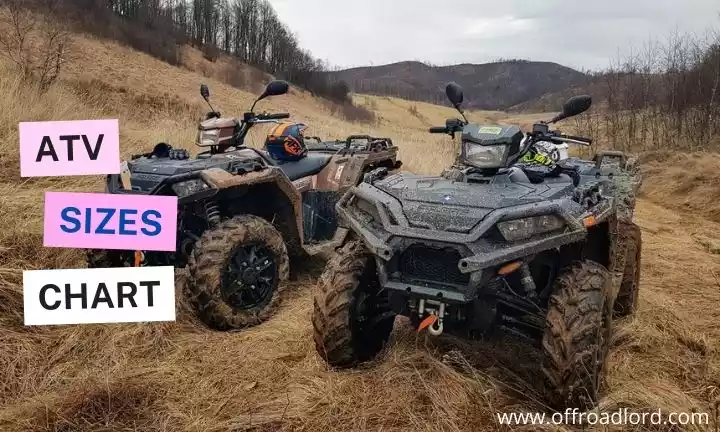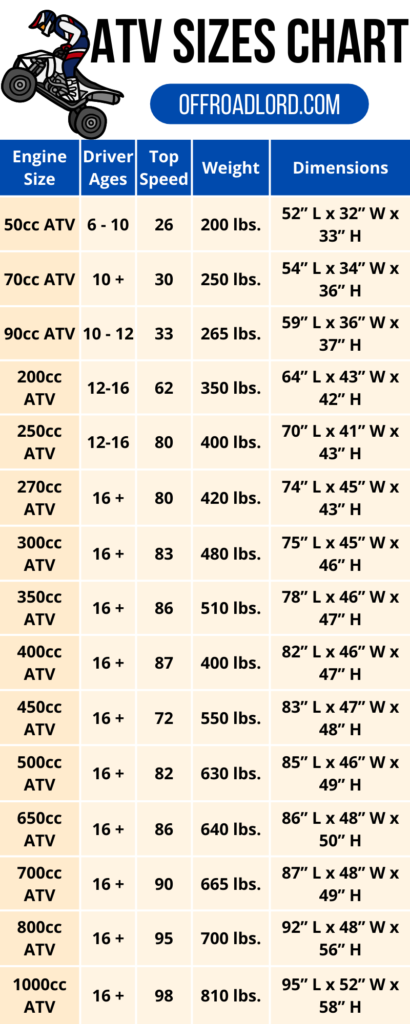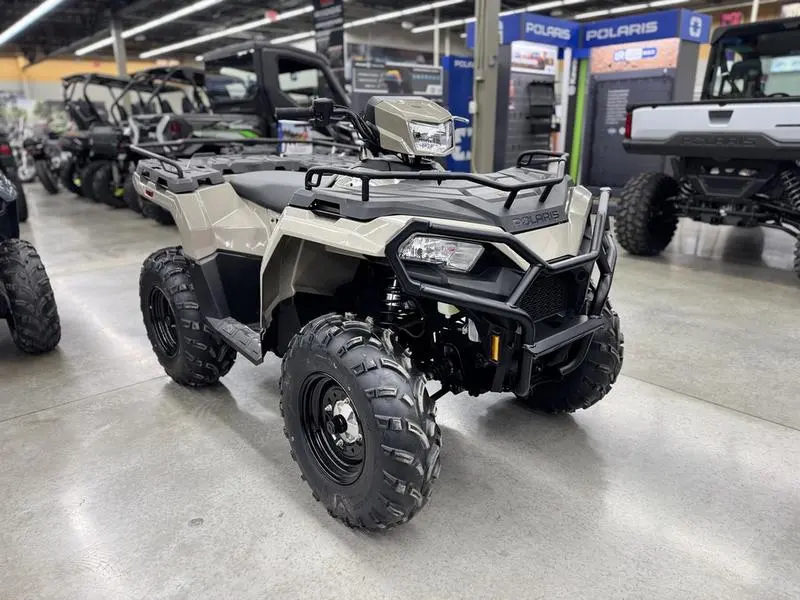Picking ATV size in 2025? Think dimensions, not just engine cc. Start with the rider class (youth Y-6/Y-10/Y-12 or teen/adult), then confirm overall length, width, seat height, and curb weight for your trails, gates, storage, and transport.
Many public trails use “50 inches or less” gates measured at the machine’s widest point—so width matters. The ATV Sizes Chart below shows typical dimension ranges by rider/use, backed by OEM specs and CPSC/SVIA guidance to help you choose the right fit safely.
Key Takeaways
- Most adult utility ATVs are ≈ 48 in wide and 83–90 in long (see typical ATV weight for transport planning).
- Many public trails are “50 inches or less”—measure at the widest point.
- Youth models are sold by age class (Y-6/Y-10/Y-12) and include speed limiters.
- Start with rider and use, then confirm width and seat height.
- See OEM examples (Rancher, Sportsman 570, Outlander) for real dimensions.
ATV Sizes Chart (2025)

| Rider / Use | Typical Engine | Length (in) | Width (in) | Seat Ht (in) | Curb Wt (lb) | Notes / Example (OEM) |
|---|---|---|---|---|---|---|
| Youth Y-6+ (≈6–9) | 50–70cc | 50–60 | 30–37 | 23–28 | 200–300 | Factory speed limiter; adult controls speed. Example: Polaris Outlaw 70. |
| Youth Y-10+ (≈10–11) | 70–90cc | 55–65 | 33–39 | 25–30 | 250–300 | Age-graded per ANSI/SVIA; adjustable limiter. Example: Can-Am DS 90. |
| Youth Y-12+ / T-14+ | 90–200cc | 60–70 | 36–42 | 28–32 | 270–360 | Transitional teen models; supervision required. |
| Adult Utility (core) | 400–570cc | 82–90 | 47–49 | 33–36 | 580–820 | Typical footprint. Example: Honda Rancher 82.8×47.4×46.2; seat 33.7; curb 580. |
| Adult Utility (heavy-duty) | 650–750cc | 85–90 | 46–48 | 35–39 | 680–750 | Example: Kawasaki Brute Force 750 86.4×46.5×48; seat 35.8; curb 699. |
| Sport / Big-bore | 700–1000cc | 86–95 | 47–50 | 34–39 | 700–900 | Example: Polaris Sportsman 570 83×48×47; seat 33.25. Outlander 700 89.9×48.8×48.2. |
Trails marked “Open to vehicles 50″ or less in width” require your ATV to be ≤50 inches at its widest point—measure tire bulge and accessories; don’t guess.

Youth ATV sizing (SVIA/CPSC)
What the age classes mean
- Y-6+ (Youth 6 and older): Smallest youth ATVs for roughly ages 6–9, always with adult supervision.
- Y-10+ (Youth 10 and older): For about ages 10–11; youth-only machines with tighter design/performance limits.
- Y-12+ (Youth 12 and older): For roughly ages 12–15; still not adult ATVs.
- T (Transitional): Intended for riders 14+ with adult supervision (or 16+); bridges youth and adult sizes.
Speed control (parent-set limiters)
- Youth ATVs include speed limiters. A Y-6 machine must be limitable to about 10 mph; Y-10 models are typically set around 15 mph when adjusted by an adult.
- Common examples (follow your manual):
- Can-Am DS 70 ships restricted near ~10 mph; DS 90 near ~15 mph (adjustable by limiter screw).
- Polaris Sportsman 110 is delivered under ~15 mph; adult adjustment allows higher speeds for experienced youth where permitted (See fastest ATV models).
- Polaris Phoenix 200 (teen) is delivered around ~20 mph and can be adjusted up to ~30 mph by an adult.
Safety rules to pair with sizing
- Adult supervision for all riders under 16; use age-appropriate youth models only (ATV Sizes By Age).
- Stay off paved/public roads (except lawful crossings).
- One rider unless designed for two. Always wear a DOT helmet, eye protection, gloves, boots, long sleeves/pants.
How to use this section
- Re-check fit (reach to bars/controls) and re-train as speeds increase.
- Choose the correct age class (Y-6 / Y-10 / Y-12 / T).
- Set the speed limiter per the manual and rider ability.
Adult ATV dimensions that matter

Width (trail access, racks, transport)
Most adult utility ATVs are about 48 inches wide, which fits many racks, trailers, and storage spaces—and keeps you close to ≤50″ trail limits in some areas. Examples: Polaris Sportsman 570 (48″ wide; 83″ long; seat 33.25″) and Honda FourTrax Rancher (47.4″ wide; 82.8″ long; seat 33.7″).
Trails signed “50 inches or less” are measured at the widest point (outer tire to tire), so accessories/tires can push you over—measure your exact setup.
Seat height (control and comfort)
Pick a seat height you can control—most adults are comfortable around 33–39 inches. For reference, the Rancher’s seat height is 33.7″ (more approachable), while a big-bore utility like the Can-Am Outlander 700 sits higher at ~38.6″ for ground clearance and travel. Try sitting with boots on before you buy.
Wheelbase & overall length (stability and pickup-bed fit)
Longer wheelbase = more straight-line stability and room, but check storage/transport. Typical adult utilities span ~83–90 inches long with wheelbases around 50–53 inches: Sportsman 570 (83″ L; 50.5″ WB), Rancher (82.8″ L; 50.0″ WB), Outlander 700 (89.9″ L; 53″ WB). If you plan to load in a pickup, measure the bed length and between-wheel-well width first.
Weight (transport and payload)
Heavier ATVs ride planted but demand more from ramps, trailer GVWR, and truck payload (See typical ATV weight). Expect ~580–850+ lb depending on model/trim: Rancher lists ~580 lb curb weight, while Outlander 700 spec sheets show ~858–876 lb estimated dry weight (varies by trim). Verify your exact unit and account for accessories/fuel.
Quick fit checklist
- My trails and gates allow ≤50″ or more? (Measure the ATV at the widest point.)
- I can sit and comfortably reach bars/controls (seat height suits me).
- Wheelbase/length fit my storage and transport plan (pickup/trailer).
- My truck/trailer ratings cover the ATV’s curb/dry weight plus gear.
Tip: If you’re close to a 50″ limit, choose narrower tires and avoid wheel spacers or wide mirrors/boxes that can add width and disqualify you from restricted trails. US Forest Service
Types of ATV And What Type is Right For You
Transport fit — pickup vs trailer
Can your ATV ride in a pickup bed?
- Measure first: bed length (tailgate up/down), width between wheel wells, and payload rating. Many adult utility ATVs are ~83–90 in long and ~48 in wide; a short (5.5 ft) bed often needs the tailgate down.
- Between-wheel-wells: 48-inch ATVs may fit in some full-size beds but usually don’t fit mid-size beds. Tire bulge, racks, or nerf bars can add width—measure at the widest point.
- Payload check: Truck payload must cover ATV curb weight + ramps + gear + passengers. If you’re close to the limit, use a trailer.
Loading ramps (do this right)
- Use rated arched ramps (or 3 single ramps) whose combined rating > ATV weight.
- Strap ramps to the truck before loading; choose level ground or back up to a berm to reduce the angle.
- Load in low gear with steady throttle; have a spotter; never spin tires on wet metal.
- Once aboard, put the ATV in park, set brake, and chock if needed.
Tie-down basics
- Four straps minimum: two front, two rear, to frame-rated points (use soft loops).
- Compress suspension ~⅓ so straps don’t loosen; cross the front pair for lateral stability.
- Re-check strap tension after the first mile and at each stop. Avoid hooking to racks/handlebars only.
When a trailer is the better choice
- Bed width/length or payload won’t work, or you carry passengers/gear.
- Frequent loading/unloading (trailers are lower and safer).
- You want to keep the tailgate closed and rear camera/sensors usable.
Trailer sizing & setup (single ATV)
- 5×8 fits most 48-inch-wide utility ATVs; 5×10 offers easier tie-downs and room for gear.
- Verify deck width between rails, axle rating, and GVWR exceed the ATV + accessories.
- Aim for tongue weight = 10–15% of loaded trailer weight to prevent sway.
- Use the correct hitch class, safety chains, working lights, and (when equipped) brakes/breakaway.
- Position the ATV slightly forward of the axle, centered; chock the tires; four tie-downs as above.
Tip: If you routinely straddle weight limits or 50-inch trail rules, a light 5×8 trailer plus a 48-inch utility ATV is the most stress-free combo for transport and access.
FAQs: ATV Dimensions
Q1. What’s the average width of an adult utility ATV?
A: About 47–49 inches. For example, Sportsman 570 is 48 in wide and Rancher is 47.4 in wide. Always verify your exact trim and tire setup.
Q2. How fast should a youth ATV go?
A: Youth ATVs include adult-set speed limiters. A common setup is under ~10 mph from the factory on entry-youth models (e.g., Outlaw 70) with an adult-adjustable maximum around ~15 mph; teen models like Phoenix 200 ship near ~20 mph and can be limited or increased (up to ~30 mph) per the manual. Follow the model’s instructions and ride within ability.
Q3. Why do some trails say “50 inches or less”?
A: Land managers designate narrow trails for small off-highway vehicles. “Open to vehicles 50″ or less” means your machine must be ≤50 inches at the widest point (outer tire-to-tire; accessories count). Measure—don’t guess.
Q4. Which seat height fits most adults?
A: Many riders are comfortable in the ~33–39 in range. For reference, Rancher is 33.7 in (more approachable) while Outlander 700 sits around 38.6 in for extra ground clearance and travel. Try before you buy.
Sources (primary)
- CPSC / SVIA youth categories & guidance: Y-6+/Y-10+/Y-12+ definitions and compliance. U.S. Consumer Product Safety Commission+1
- USFS “50 inches or less” rule: width measured at the widest point on the vehicle. US Forest Service
- Polaris youth limiter references: Outlaw 70 (restricted <10 mph; ~15 mph max) and Phoenix 200 (delivered ~20 mph; adjustable to ~30 mph). Polaris+1

Calvin Anderson, founder of Off-Road Lord, is a seasoned off-roading enthusiast from Tucson, Arizona. With over a decade of hands-on experience and a deep understanding of off-roading vehicles and trails, Calvin’s insights provide a trusted guide for fellow adventurers.